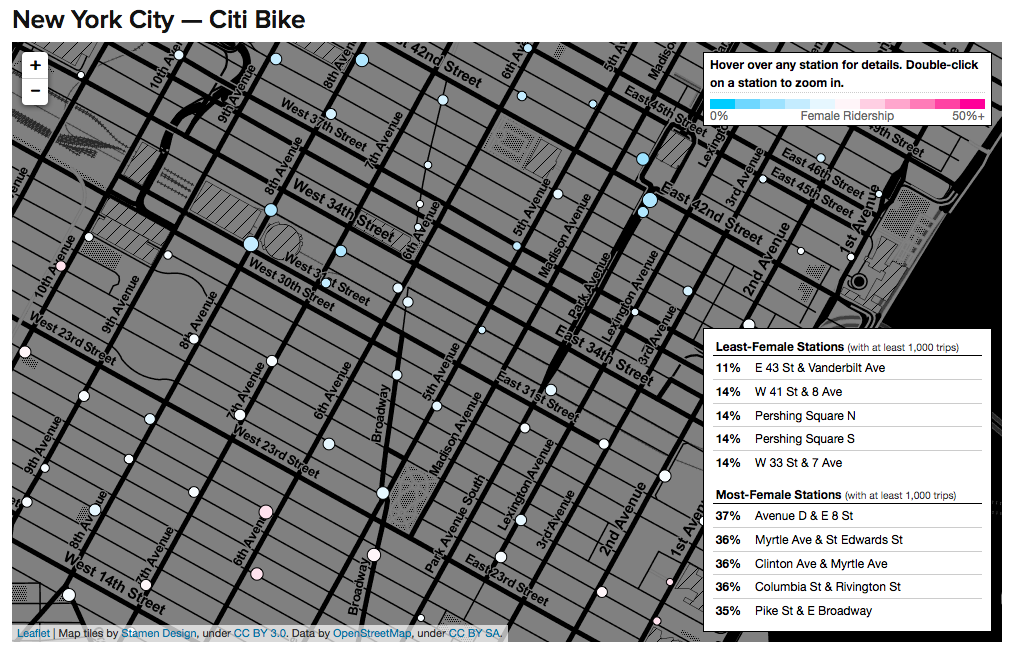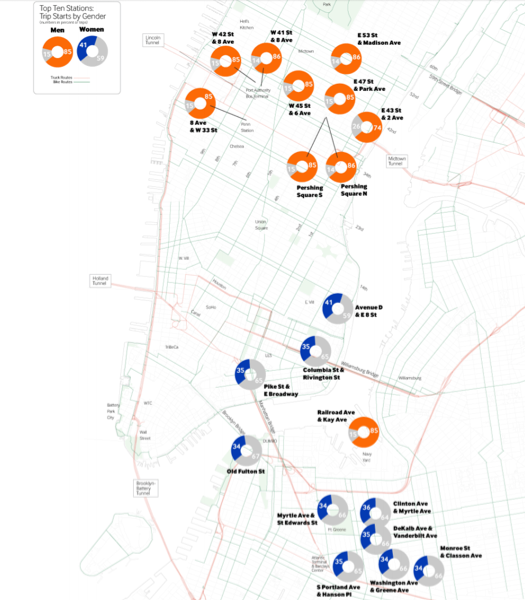DISCOVER YOUR LOCAL BICYCLING COMMUNITY
Find local advocacy groups, bike shops, instructors, clubs, classes and more!
Bike Share’s Gender Gap
All eyes were on New York City last year, as they launched the nation’s largest bike sharing system. With strong female ridership in places like Washington, D.C. and Minneapolis, there were high hopes that bikesharing in the Big Apple would boost the number of women biking. So the release of data showing Citi Bike skews heavily male, left some folks scratching their heads.
I had a chance to discuss the issue with a reporter from Buzzfeed, who had delved into the station-by-station data for, not just Citi Bike but bike sharing in Chicago and Boston, as well. By his analysis, only 24% of Citi Bike trips over the first year were taken by women, with some stations clocking as few as 11% of trips by female riders. His question: What’s keeping ladies out of the saddle?

Living in D.C. during the first few years of Capital Bikeshare, I’ve seen firsthand the incredible uptick in women riding our eye-catching red bikes. As I told Atlantic Cities last year, bike sharing has played a role in lowering barriers to participation for women by putting bikes at their finger tips, making cycling quick and convenient for urban trips, designing bikes that are conducive to wearing everyday clothing and, perhaps most importantly, elevating biking to a more visible, mainstream mode of transportation.
Still, there are challenges to overcome. As we shared in our Women on a Roll report, women are more likely to pick up and drop off children than their male counterparts, and they’re more likely to trip chain — stopping for errands on their way to and from work. So the ability (or inability) to carry cargo could be a barrier for many women. While we’ve seen a number of entrepreneurs create stylish bags for bike share, if you’ve got a toddler and a big bag of groceries, hopping on bike share isn’t an option (yet!). Women also make up 2/3 of America’s minimum-wage workers, so many have longer or off-peak commutes that make cycling difficult or unsafe. And, of course, the notion that cycling = sweat = arriving dishelved is still a too-common fear for professional women, too.
 But, I had a question for the reporter, as well: While the overall number of female trips was low, what can we learn about the stations where women were riding? For instance, are stations near bike lanes or cycletracks seeing higher female ridership? Were women, potentially, using Citi Bike to get around their neighborhoods, if not commuting to the middle of Manhattan? That was outside his purview of analysis, but, lucky for us, NYU’s Sarah Kaufman crunched those number in a guest post on Velojoy:
But, I had a question for the reporter, as well: While the overall number of female trips was low, what can we learn about the stations where women were riding? For instance, are stations near bike lanes or cycletracks seeing higher female ridership? Were women, potentially, using Citi Bike to get around their neighborhoods, if not commuting to the middle of Manhattan? That was outside his purview of analysis, but, lucky for us, NYU’s Sarah Kaufman crunched those number in a guest post on Velojoy:
In general, men are in midtown Manhattan and women are in Brooklyn – or easily accessing Brooklyn. But it’s not just about the geographic layout of the stations. Looking more closely at the station characteristics, women are gravitating toward safer locations: 40 percent of their top stations have a bike lane or protected greenway (30 percent for male-preferred stations). Women also choose stations on lower-traffic streets, with an average of two lanes of traffic, and highly restricted truck access; men’s top station streets average 2.6 lanes of traffic and mostly unrestricted truck access. Finally, these stations vary in their recent safety records: between March 2013 and February of 2014, the stations preferred by women have a lower average number of cyclist injuries in recent memory: 0.8 for female-preferred locations versus 1.3 for male-preferred locations. The memory of safety conditions likely affects station and route choices.
The take-away for me? Bike sharing and better infrastructure are both critical, transformative pieces in the complex puzzle of making bicycling more appealing to women. As we emphasize in our Bicycle Friendly Community program, there’s no silver bullet. It takes all five Es — engineering (like bike lanes), education, encouragement, evaluation and enforcement — to get more folks out riding. That’s certainly happening in NYC — and the numbers show a dramatic rise in women riding.
Some may recall a study released earlier this year from researchers at Hunter College. In their observational study, more than 21% of riders were women — double the share of women they observed in a similar study just four years ago. They also observed that more than 30% of Citi Bike riders were women — and the percentage of female bikeshare riders was nearly twice as high on streets with bike facilities (i.e. 5% of riders on streets without a bike lane vs. 10% of riders on streets with protected bikeways).
But getting more women riding goes beyond the nuts of bolts of bikes and lanes. It’s about community and social networks, too. This year, CycloFemme bridged that gap by working with Citi Bike to offer discounts for women to hop on a blue bike to be part of the international day of women’s cycling solidarity. And groups like WE Bike NYC are creating space for women, no matter their type of riding, to feel engaged in the bike movement and comfortable on their city streets.
As Casey Ashenhurst, director of WE Bike NYC, told Transportation Alternatives earlier this month: “Women are taking to two wheels for the same reason all New Yorkers are biking more: People feel comfortable. We’ve had women join rides on cruisers, hybrids, road bikes and track bikes. That diversity shows women there is more than one way to ride a bike. New bike lanes and more women riding make it less intimidating for women to ride a bike, whatever way makes sense to them.”
So, as more women get out and ride in “whatever way makes sense to them,” will we start to see more balanced bike share ridership? Kaufman thinks so:
The bloomers of 2014 are Citi Bikes: Women tend to make more multi-stop trips, so they can better use the pickup and drop-off features of Citi Bike. Bike Share is also a great way to work out efficiently, rather than commuting to a gym. And most importantly, the more bikers there are out there, the safer all cyclists are. So with the new freedom of mobility afforded by Citi Bike, women may just connect with the same spirit of liberty that their 19th-century foremothers experienced in their revolutionary new garb.
What do you think? Share your thoughts in the comments! And stay tuned for a Q&A with Chicago’s Divvy bike share on their efforts to increase female ridership with Women’s Bike Month.